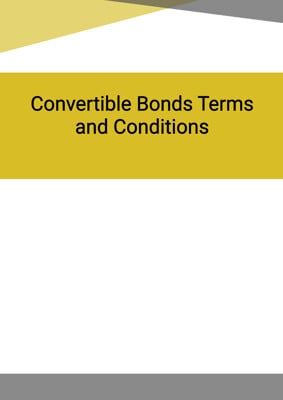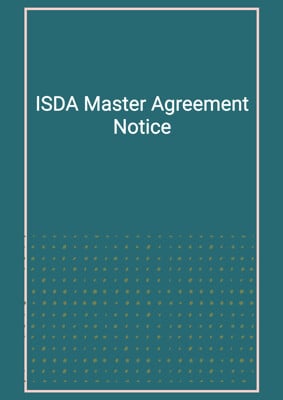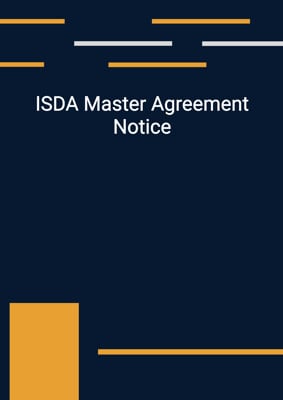
Unsecured Loan Note and Conditions
Private Issuance
This document is a template used as an Unsecured Loan Note with Conditions. This is similar to a private issuance of the bond. Bonds and Notes are negotiable debt instruments generally issued by Companies or government authorities. It is a way to borrow money from investors without having to go to the banks.
How to Tailor the Document for Your Need?
01
Create Document
Click "Create Document" button and the document will be prepared with your account details automatically filled in.
02
Fill Information
Please fill in any additional information by following the step-by-step guide on the left hand side of the preview document and click the "Next" button.
03
Get Document
When you are done, click the "Get Document" button and you can download the document in Word or PDF format.
04
Review Document
Please review the document carefully and make any final modifications to ensure that the details are correct before publication / distribution.
Document Preview
Document Description
The document titled 'Unsecured Loan Note and Conditions' is a legal document that outlines the terms and conditions of an unsecured loan. It is important because it serves as a written agreement between the lender (the company) and the borrower (the registered holder of the note). The document starts with a note number and the amount of the loan in a specific currency. It also includes the name of the holder and states that it is an unsecured loan note.
The document is divided into several sections, each addressing different aspects of the loan. The first section states that the company will pay the principal sum of the loan along with any interest according to the conditions mentioned in the note. It also mentions that the note is subject to the laws of the jurisdiction country.
The second section provides detailed definitions of terms used in the note, such as directors, noteholders, and notes. It clarifies that words denoting the singular number also include the plural number and vice versa. It also states that words denoting the masculine gender include the feminine and vice versa. Additionally, it mentions that words denoting persons include corporations. It further explains that any words and expressions defined in the companies law of the jurisdiction country have the same meaning in this note.
The third section discusses the creation and issue of the notes. It states that the amount of this series of notes is authorized and that the company has the power to create and issue additional notes in the future. It also mentions that all notes issued will rank equally and will be unsecured obligations of the company.
The fourth section addresses the payment of interest on the notes. It states that no interest shall be payable on the notes unless specified otherwise. If interest is applicable, it mentions the rate at which the interest will be calculated and the frequency of payment.
The fifth section discusses the repayment of the notes. It states that any outstanding notes on the due date shall be repaid in full, along with any accrued interest. It also mentions the circumstances under which the notes may become immediately repayable, such as if the company is winding up or unable to pay its debts. It further explains that if any amount is not repaid on the due date, interest will start to be payable by the company at a default rate until the date of actual payment. It also outlines the process of repayment and the cancellation of repaid notes.
The sixth section establishes the register of noteholders. It states that the company is required to maintain a register showing the names and addresses of the noteholders, along with the amount of their respective holdings and the dates of registration. It also allows noteholders and authorized persons to inspect the register and take copies or extracts from it.
The seventh section addresses the title of noteholders. It states that the company recognizes the registered holder of any note as the absolute owner and is not bound to take notice of any trust to which the note may be subject. It also mentions that the receipt of the registered holder for any moneys payable in respect of the note is a good discharge to the company. It further clarifies that every noteholder will be recognized as entitled to the note free from any equity, set-off, or cross-claim on the part of the company.
The eighth section discusses the transfer of notes. It states that no noteholder can transfer the ownership of any notes registered in their name except through a written instrument in the approved form. It also outlines the process of transferring notes and the issuance of fresh notes for partial transfers.
The ninth section addresses the renewal of notes. It states that if a note is defaced, worn out, lost, or destroyed, it can be renewed upon payment of a fee and compliance with the company's requirements. It also mentions that if a note is lost or destroyed, the person availing themselves of this condition must pay all expenses related to the investigation and indemnity.
The tenth section discusses the process of giving notices under the note. It states that notices can be given to the company or noteholders by sending them by post to the registered office or address. It also mentions the time frame for deemed service and the requirements for proving proper service.
How to use this document?
1. Enter the necessary information: Fill in the note number, amount, and holder's name in the provided spaces. This ensures that the document is personalized and reflects the specific loan details.
2. Understand the conditions: Read and familiarize yourself with the conditions mentioned in the note. This will help you understand your rights and obligations as a noteholder.
3. Determine the interest rate: If applicable, calculate the interest rate mentioned in the note. This will help you understand the additional amount you may need to repay.
4. Repayment on the due date: Ensure that you repay the outstanding note amount in full on the due date mentioned in the note. This will fulfill your repayment obligation.
5. Immediate repayment circumstances: Be aware of the circumstances under which the notes may become immediately repayable, such as winding up of the company or inability to pay debts. Take necessary actions if any of these circumstances arise.
6. Process of repayment: Follow the process mentioned in the note for the repayment of the notes. Deliver the note to the company's registered office and receive the payment against it. Keep a receipt for future reference.
7. Register of noteholders: Understand your rights to inspect the register of noteholders and take copies or extracts from it. This will help you stay informed about other noteholders and their holdings.
8. Transfer of notes: If you wish to transfer the ownership of your notes, follow the approved process mentioned in the note. Prepare a written instrument of transfer and submit it to the company's registered office.
9. Renewal of notes: If your note is defaced, worn out, lost, or destroyed, follow the renewal process mentioned in the note. Pay the required fee and provide the necessary evidence and indemnity.
10. Giving and receiving notices: Ensure that you provide accurate and up-to-date contact information to receive notices. Keep track of the time frame for deemed service and be proactive in responding to any notices received.
Not the right document?
Don’t worry, we have thousands of documents for you to choose from:















